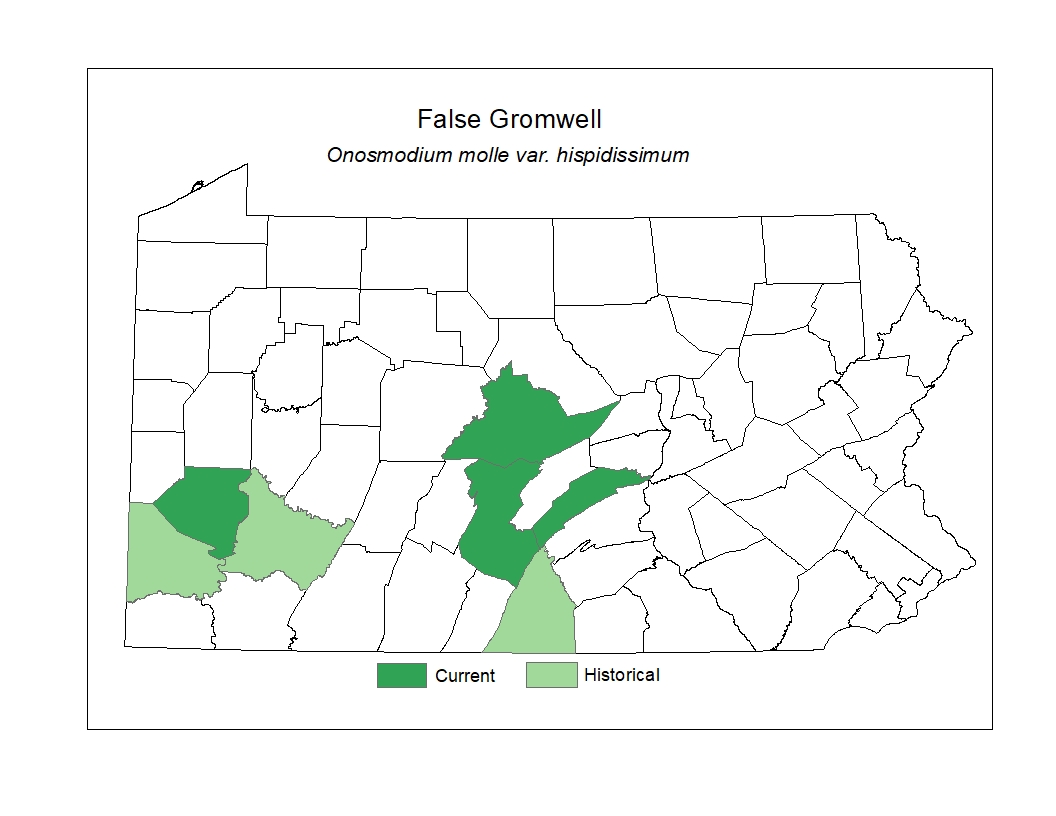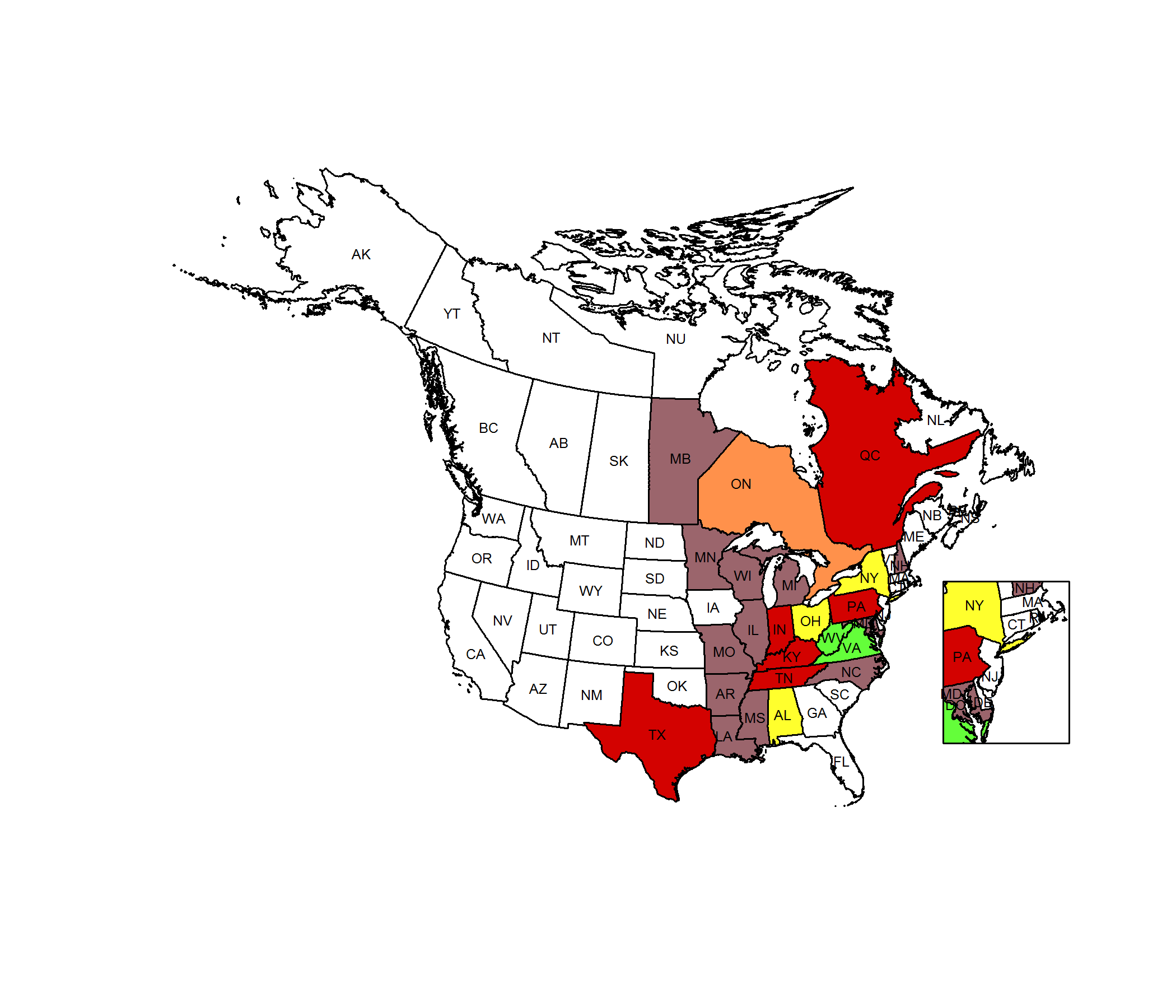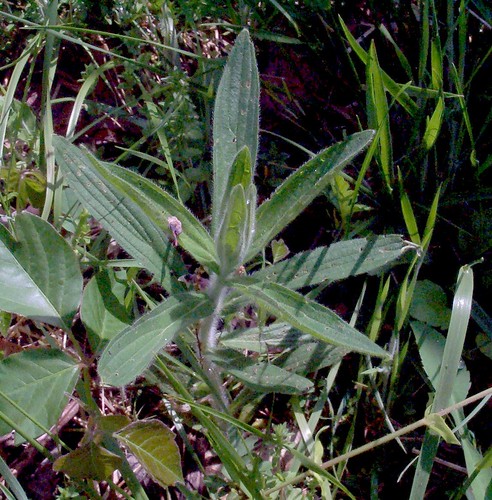 Species Factsheets
Species Factsheets
Onosmodium molle var. hispidissimum
False Gromwell
State Status: Pennsylvania Endangered (PE)
PBS Status: Pennsylvania Endangered (PE)
Federal Status:
Global Rank: G4G5T4
![]() rank interpretation
rank interpretation
State Rank: S1
Did You Know?
A long, white style sticks out from the tube like that of a stinger, and it reamins even after the petals wilt away.
Description
False gromwell (Onosmodium molle var. hispidissimum) is a perennial herb that reaches up to one point 2m in height. Its woody base gives rise to several leafy stems that are coarsely hairy. The leaves are also hairy and grow on the stem in an alternate arrangement. They are narrowly oval, 8-10cm long, and attach without a leaf stalk. Lower stem leaves are smaller and fall early. The flowers appear from late June to early July and are held in leafy spikes that curl downward. Individual flowers are small, up to 16mm, white or greenish, and tube-shaped, with five broadly- pointed lobes. Fruits are small, rounded nutlets that are constricted at the base.
Rank Justification
Critically imperiled in the nation or state because of extreme rarity (often 5 or fewer occurrences) or because of some factor(s) such as very steep declines making it especially vulnerable to extirpation from the state.
PABS
The PA Biological Survey considers the false gromwell to be a species of special concern, based on the relatively few occurrences that have been confirmed and the very specialized habitat. It has been assigned a rarity status of Endangered.
Habitat
False gromwell occurs in the U. S. from New Hampshire and New York west to Minnesota and Texas. In Pennsylvania, it can be found growing on calcareous dry hillsides and in old pastures.
Survey Dates
Flowers late June - early July
Distribution

Threats
Throughout the range of this species, habitat loss, land conversion for development, and displacement by invasive species have all played a part in its decline. In some cases, the communities where this species grows are themselves rare or have succeeded into a different community types due to the overgrowth of woody species and invasive species.
Management
Maintenance of known populations and preservation of the rare communities where false gromwell grows will be crucial to its survival. Removal of overgrowth and invasive species with the integration of fire regimes, when appropriate, will help to preserve the integrity of the sites. The management of the known sites requires long term monitoring of populations. Potential sites for restoration should be evaluated.
Conservation Status Map


NatureServe. 2017. NatureServe Explorer: An online encyclopedia of life [web application]. Version 7.1. NatureServe, Arlington, Virginia. Available https://explorer.natureserve.org.
https://www.minnesotawildflowers.info/flower/false-gromwell
- NatureServe. 2018. NatureServe Explorer: An online encyclopedia of life [web application]. Version 7.1. NatureServe, Arlington, Virginia. Available at https://www.natureserve.org/explorer
- Pennsylvania Natural Heritage Program. 2018.
- Rhoads, A.F. and W.M. Klein, Jr. 1993. The Vascular Flora of Pennsylvania. American Philosophical Society, Philadelphia, Pennsylvania. Rhoads, A.F. and T.A. Block.
- 2007. The Plants of Pennsylvania: An Illustrated Manual. 2nd edition. University of Pennsylvania Press, Philadelphia, Pennsylvania.







